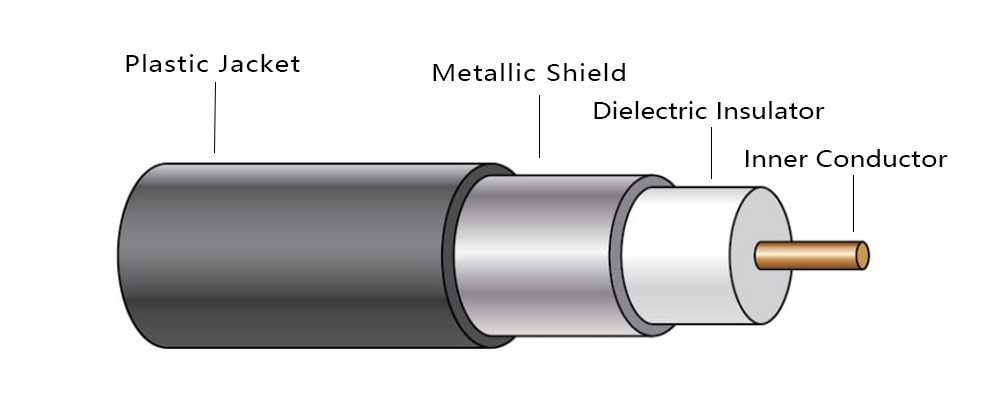In today hyper-connected world, cables remain the backbone of data, video, and audio transmission, even as wireless technologies advance. From high-speed broadband to immersive 8K streaming, the coaxial cable—or "coax"—stands out for its robust shielding and efficiency in handling high-frequency signals. Drawing from historical roots to innovations like DOCSIS 5.0 and hybrid fiber-coaxial (HFC) networks, we'll uncover why coax endures in modern infrastructure.
The Anatomy of a Coaxial Cable
Coaxial cable earns its name from the "coaxial" alignment of its inner and outer conductors along a shared axis. Patented in 1880 by Oliver Heaviside, this design revolutionized signal transmission by minimizing interference—a breakthrough that eliminated crosstalk in early telegraph and telephone lines. Today, it's a transmission line optimized for low-loss, high-frequency signals up to several gigahertz.
The structure typically comprises four layers:
Inner Conductor: Often solid or stranded copper (sometimes silver-plated or copper-clad steel) that carries the signal. For high-power RF, rigid types like Heliax use corrugated copper for flexibility and low attenuation.
Dielectric Insulator: A non-conductive material such as polyethylene foam, PTFE (Teflon), or even air with spacers, maintaining constant spacing for impedance control (commonly 50 or 75 ohms). Foam dielectrics reduce losses by incorporating gas but can absorb moisture in humid environments.
Shielding Layer: One or more layers of braided metal (copper or aluminum) or foil, acting as a Faraday cage to block external noise and prevent signal leakage. Quad-shielding alternates foil and braid for superior performance.
Outer Jacket: A protective PVC or specialized sheath (e.g., UV-resistant or fire-retardant) for environmental durability.
In ideal conditions, the electromagnetic field is confined between conductors, enabling installation near metal without losses. Analogy: Think of it as a fortified pipeline— the core transports the "fluid" (signal), insulation prevents leaks, shielding wards off contaminants, and the jacket withstands the elements.
Common types include RG-6 (for cable TV) and RG-58 (for RF), with impedances tailored to applications.

Twisted Pair Cables: A Complementary Counterpart
Invented by Alexander Graham Bell in 1881 to combat noise in early telephony, twisted pair cables use a simpler mechanism: pairs of insulated copper wires twisted together to cancel electromagnetic interference via differential signaling. The twisting ensures equal exposure to noise sources, converting it to a common-mode signal that's easily rejected at the receiver.
Key variants:
Unshielded Twisted Pair (UTP): Common in Ethernet (e.g., Cat5e, Cat6), with no outer shield—relying solely on twist rates (twists per meter) to minimize crosstalk. Different pairs have varying rates to prevent alignment.
Shielded Twisted Pair (STP): Adds foil or braid (e.g., F/UTP or S/FTP) for extra protection in noisy environments, like Cat7 for 10GBASE-T.
Analogy: Like synchronized dancers, the twists balance external forces, allowing smooth movement. However, deformation during installation can impair performance, limiting it to shorter runs compared to coax.
Highway vs. Backstreet: Contrasting Transmission Paths
Coaxial as a Sealed Expressway: High bandwidth, superior shielding for long distances (hundreds of meters), but higher cost and rigidity. Ideal for RF where precision matters.
Twisted Pair as Urban Lanes: Economical, flexible for "last-mile" access, but prone to interference without shielding. Suited for data networks up to 40Gbps in Cat8.
Coax excels in shielding and high-frequency handling, while twisted pair wins on cost and ease for LANs. Fiber optics have overtaken long-haul, but coax persists in hybrid setups.
Real-World Applications: Enduring Relevance in Future
Coaxial cables power diverse sectors:
Cable TV and Broadband: RG-6 delivers signals via DOCSIS 4.0/5.0, supporting gigabit internet in HFC networks—projected to grow to $16.5 billion in market size.
Surveillance and AV: Used in CCTV and professional video (e.g., SDI), with radiating "leaky" types for tunnels.
RF and Antennas: Connects radios, ham setups, and 5G infrastructure.
Networking Legacy: Once key for Ethernet (10BASE2), now niche but vital for cable modems.
Twisted pair dominates:
Networking and Telephony: Ethernet LANs, VoIP, with outdoor bundles for global landlines.
Building Automation: PoE for devices, supporting up to 2GHz in Cat8.
Innovations: Coaxial Elements in Ultra-Thin HDMI Cables
Traditional HDMI cables thicken with performance, but slim variants integrate coaxial cores for "slim, stable, high-bandwidth" transmission—handling 48Gbps for 8K.
Breakthroughs include:
Materials: High-purity silver-plated copper or alloys for thinner, conductive cores.
Shielding: Multi-layer foil and dense braids, echoing coax to ensure purity.
Insulation: Low-loss polymers like FEP reduce attenuation.
Encoding: HDMI 2.1's Fixed Rate Link (FRL) with error correction enables compact data flow.
These fuse coax advantages with flexibility, powering clutter-free setups. In AV evolution, enhanced coax materials boost performance without bulk.
Endnote: Coax's Timeless Role
From Heaviside's 1880 patent to 2025's 5G and HFC integrations, coaxial cables represent enduring engineering—prioritizing stability for high-stakes transmission. While twisted pairs offer affordability for everyday data, coax's shielded prowess ensures it thrives. As tech advances, hybrids like coaxial-infused HDMI exemplify "small yet mighty" innovation, keeping our world seamlessly linked.
Tag:Coaxial Cable,HDMI




